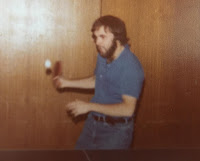I continued playing ping pong in college. I bought one of those paddles that has foam under the rubber so the ball stays in contact with the surface for a long time, letting you impart more spin. During my first two years at the University of Kansas, I studied but also spent a lot of time playing ping pong at the dorm. I was better than most of the guys, although my friend Son Do could beat me, much to my chagrin. Too many evenings were squandered playing cards or ping pong. Only during my last couple years at KU did I get serious about physics.
 |
| Life in Moving Fluids, by Steven Vogel. |
A look at the resulting streamlines (Figure 10.12 [a modified version of which is shown below]) clarifies what’s happening in this superposition of rotation and translation of a cylinder. On one side of the cylinder the two motions in the fluid oppose one another, so the velocities are lower and the streamlines are farther apart. On the other side, the motions are additive, velocities are increased, and the streamlines are closer together. By Bernoulli’s principle pressure will be elevated on the side where flow speeds are lower and will be reduced on the side where the speeds are higher. Thus a net pressure or force will act in a direction normal to the free-speed flow—in short, lift…
H. G. Magnus (1802-1870).
The Magnus effect (at a little lower intensity) works for spheres as well as for cylinders. It’s a really big deal in sports in which spheres are thrown, hit, or otherwise put into motion since (except for a golf slice) a confusingly nonstraight course is distinctly meritorious. Two pleasant books on such contemporary compulsions are Sport Science, by P. J. Brancazio (1984), with good references, and The Physics of Baseball, by R. K. Adair (1990), with more on the Magnus effect specifically.
 |
| Me playing ping pong at the University of Kansas, circa 1980. |





No comments:
Post a Comment